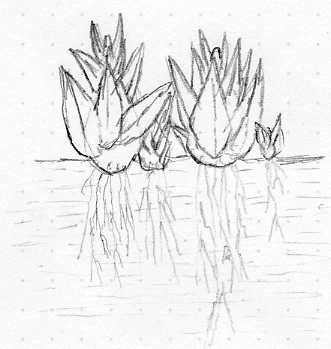

| che-chin |
|
|
|
Name:
Che-chin Indigenous:
Galen, Sargasso seas. Use:
No modern uses. Habit:
The plant forms loosely linked mats on the sea’s surface, individual
plants live for a few years. Rarely the plants form mats off the coast,
though most vegetation trapped on the land does not survive desiccation
between high tides. Marginal aquatic forms of Che-chin do exist, though
they have lost their ocean going habits. Favoured
conditions: Che-chin is one
of the more common plants found in Gadarren’s floating vegetation, it
is predominantly found in the temperate seas in the shallow water off
the continents. Many of the larger mats of vegetation continuously
re-circulate in the currents, though occasionally the mats come closer
to shore, or even fragment and become stranded. Che-chin is a hardy
marine species, though can not tolerate conditions any significant
degree below freezing, it also benefits from unobstructed sunlight, not
generally a problem unless it is growing within an already complex
Sargasso. Structure:
The plant is simple in structure; leaves are arranged in a rosette
around a single bud. This bud forms the bulbous float that supports the
plant in the water, though the upper most growing tip of the plant is
dense growing plant tissue immediately beneath this the tissue is
expanded and pithy. This swollen bud/stem provides the buoyancy of the
plant. The inner foamy pith plays little other part in the plants
biology, the real living tissue is the skin surrounding the float, the
leaves connect to this skin by simple axils, sometimes at these leaf
axils smaller plants develop which is the principle route through
vegetative propagation occurs. The plant grows to about 20cm across,
tapering slightly to a conical shape. Viewed from above the leaves are
delicately arranged in a single spiral, with both the angular spacing
and the leaf size decreasing as the leaves approach the central growing
tip at the top of the cone. From the spheroid bottom of the plant a
number of major roots grow from the bottom a little like tap roots,
elsewhere on the plants underside finer and mat-forming horizontal roots
grow. Though both root types are important for the plant to exchange
minerals and water with the sea, the vertical roots are specifically
important because these long roots intersect the subsurface currents are
in part responsible for defining how the plants move. Foliage:
Che-chin’s lineage is from a relatively separate group of plants in
Gadarren’s ecology, the leaves are simple, they do not show any
ribbing or complex vein structure. The leaves are almost uniformly
thick, and lanceolate. The leaf junction with the body of the plant is
simple, though as mentioned above this axil can develop new buds that
expand into new plants. The leaves are green/bronze though the bronze
colour can reflect a defence response to excess sunlight, or other
stress (e.g. UV). Sometimes a reddish/bronze vertical stripe can be
observed from the leaf tip to the leaf axil, though certain species
exhibit this more frequently than others, the reason is not genetic, but
rather a combination of epigenetic and environmental factors. Flowering
and fruits: Vegetative propagation in the most significant route for
reproduction in most species, and this occurs as a simple budding
process, where the new plantlets abscise off the parent. Rarely, and
seasonally the plant does produce flowers. The sexual parts of the plant
develop as a ring beneath the growing tip, and are simple in structure.
The male gametes are formed in papules growing in the skin and are
released either through contact (for example by striking with another
plant), or through desiccation and splitting of the skin by a
combination of aging and heat. The female gametes are also on the skins
surface though supporting cells that excrete a droplet of dew over the
ovum. Fertilization is usually through contact with a neighbouring
plant, where the male pollen is trapped on the dew like beads on the
opposing plant. The fertilised egg is briefly retained until it grows to
form a spore, which is then shed from the plant; from this point the new
embryo is independent of the parent, though marine fauna frequently
consume the young seedlings. Sexual reproduction is more successful in
established Sargassos as the other plants hide and nurture the
developing plants. In terms of reproductive routes sexual reproduction
is favoured when the plants are mat forming, where not only the mating
partners are available, but also an increased chance of progeny
survival. Sexual breeding is also an important way of exchanging genetic
material in communities as well as developing favourable characteristics
(genetic variety). Asexual reproduction by contrast is best suited for
isolated plants, where it is energetically favourable and more
successful, also by this route individual plants can give rise to mats
where as seedlings are frequently lost to the open sea. Cultivation:
Che-chin has essentially remained a wild plant and has not been widely
cultivated. |











